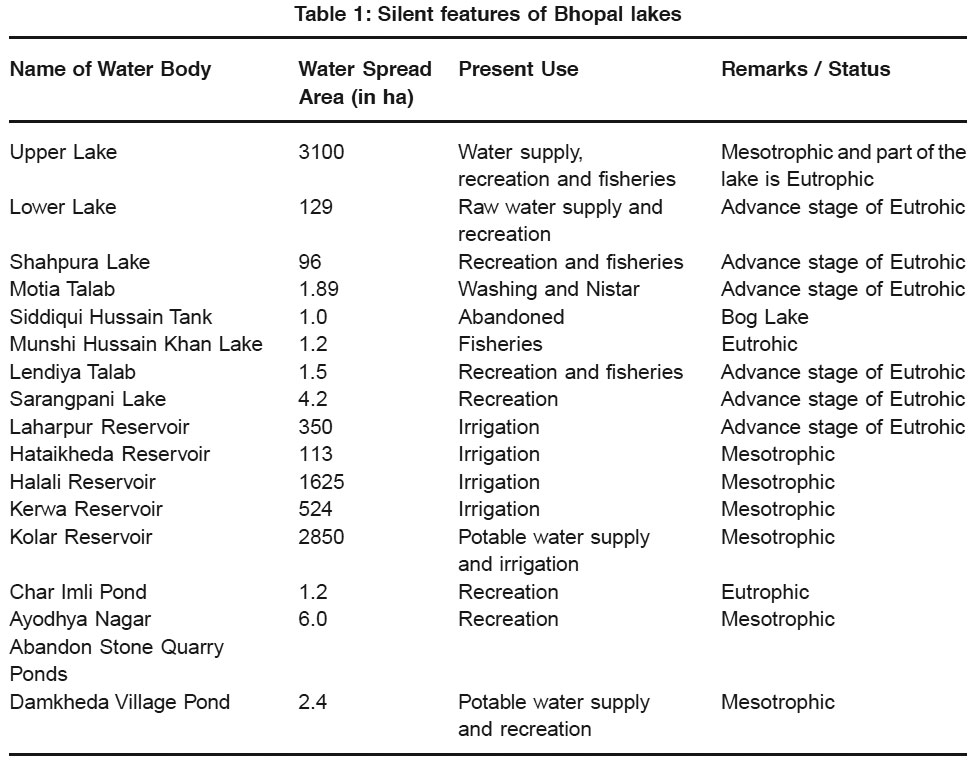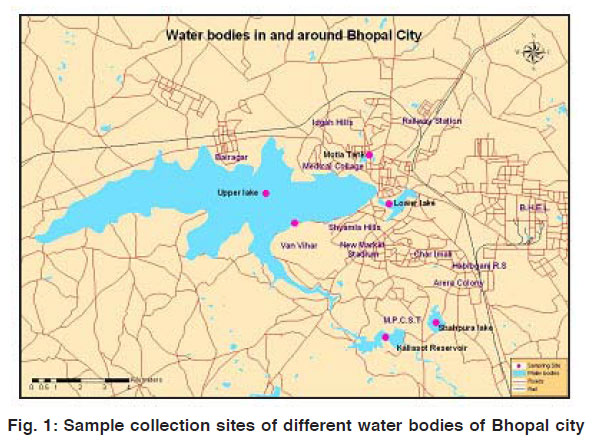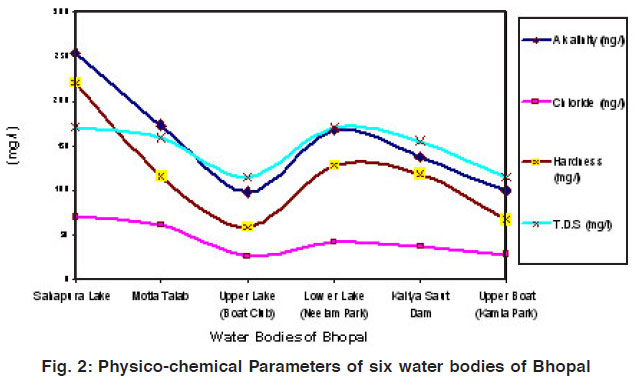Physico-chemical characteristics of certain water bodies of Bhopal, India
S. Chouhan1 * , G. Shukla1 , V. Mulchandani1 , V.K. Sharma1 and N.N. Mehrotra1
DOI: http://dx.doi.org/10.12944/CWE.4.1.08
The aim of this study is to assess physico-chemical characteristics and coliform levels to assess status of six water bodies i.e., Upper Lake at Boat Club and at Kamla Park, Motia Talab, Lower Lake, Shahpura Lake and Kalia Saut dam of Bhopal, M.P. The present study was carried out during monsoon season, 2008. The range of water quality parameters were observed as pH from 7.08 to 7.5, electrical conductivity from 0.17 to 0.56, total dissolved solids from 116.00 to 172.0, total hardness from 67.0 to 22.0, chlorides from 27.32 to 69.65, free carbon dioxide from 2.0 to 6.66 and total alkalinity from 98.66 to 255.33. Except pH, all the parameters showed high range to values in Shahpura Lake. While, pH value was maximum recorded in Upper Lake at Kamla Park. Surplus growths of fecal colonies were recorded in all water bodies. After comparing the water quality parameters with BIS standards, it may be said that, the Shahpura Lake is highly polluted than others which may be due to high anthropogenic activities around the lake and allocthonous nutrients are added to the reservoir.
Copy the following to cite this article:
Chouhan S, Shukla G, Mulchandani V, Sharma V.K, Mehrotra N.N. Physico-chemical characteristics of certain water bodies of Bhopal, India. Curr World Environ 2009;4(1):55-62 DOI:http://dx.doi.org/10.12944/CWE.4.1.08
Copy the following to cite this URL:
Chouhan S, Shukla G, Mulchandani V, Sharma V.K, Mehrotra N.N. Physico-chemical characteristics of certain water bodies of Bhopal, India. Curr World Environ 2009;4(1):55-62. Available from: http://www.cwejournal.org/?p=889
Download article (pdf)
Citation Manager
Publish History
Select type of program for download
| Endnote EndNote format (Mac & Win) | |
| Reference Manager Ris format (Win only) | |
| Procite Ris format (Win only) | |
| Medlars Format | |
| RefWorks Format RefWorks format (Mac & Win) | |
| BibTex Format BibTex format (Mac & Win) |
Article Publishing History
| Received: | 2009-03-02 |
|---|---|
| Accepted: | 2009-04-29 |
Introduction
In India about 3.15 million ha water area fall under reservoirs and 47% of this i.e., 1.48 million ha is contributed by small reservoirs alone (Sugunan, 1997). There are many wetlands available in different parts of the country. The freshwater in these wetlands is amongst the most critical factors limiting urban growth, agriculture, fisheries development and other aquatic resources. Madhya Pradesh is the second largest geographic unit of the county with an area of 3, 08, 245 km2. There are many wetland areas in the form of rivers, lakes and man-made reservoirs. The state with 0.46 million ha are under reservoirs has the maximum water spread area under man-made lakes. The small, medium and large reservoirs in the state are estimated at 1, 72, 575; 1, 67, 502 and 1, 18, 307 ha area respectively with a total of 4, 60, 384 ha (0.46 million ha). In Madhya Pradesh, Gandhisagar reservoir is the second largest reservoir in the country, next only to the Hirakund of Orissa. However, the state is all set to the top the list when the proposed Narmada Sagar reservoir (91, 348 ha) becomes a reality (Sugunan, 1997).
Aquaculture has been showing a tremendous growth during past decades (FAO, 2004). Aquaculture similar to other animal production systems generates waste. The amount and quantity of waste depends on production system and feed quality (Cho and Bureau, 1997) and can be divided into solid and dissolved waste (Cripps and Bergheim, 2000; Piedrahita, 2003). Accumulation of these pollutants deteriorates water quality in the system (Amirkolaie et al., 2005) and can increase the incidence of disease in fish (Liltved and Cripps, 1999). In order to maintain a better quality in aquaculture system, waste has to be discharged with effluent water. Discharge of aquaculture waste forms a major environmental concern because they can cause eutrophication of receiving water such as lakes and rivers (Cripps and Bergheim, 2000).
Kant and Vohra (1989) have rightly suggested that the management of any aquatic ecosystem is conservation of freshwater habitat with an aim to maintain the quality or to rehabilitate the physico-chemical and biological quantity of water. Before any step of environmental management and conservation is taken, the monitoring of water quality is the first requirement.
Bhopal city is situated at 23° 16' N and 77° 36' E with a maximum elevation of 550 meters above MSL spreading over seven hills. Bhopal city is called city of lakes because of name of its twin lakes; i.e. Upper and Lower lakes, which provide livelihood and add to scenic beauty to the city. Bhopal, which is endowed with a number of water bodies and develop over a period of over 900 years, is facing the problem of decline of water bodies since it is developing very fast and is moving to attain the status of mega city, there is need of a consolidated plan for restoration of the vital water resources. Bhopal city is embedded with 18 water bodies of diverse sizes, located in and around the city. Silent features of Bhopal lakes are present in Table 1. However, people are more familiar with only 5-6 water bodies because of their proximity to the city dwellers. Therefore, for present study six water bodies of Bhopal has been selected for monitoring of pollution status. Figure 1 depicts the map of selected water bodies of Bhopal.
Material and Methods
Sampling Sites
Upper Lake
The upper lake came into existence in 11th century. The catchment area of this lake is extended in 361 km2 areas, while water spread area is restricted to 31 km2. The upper lake remained the only major source of potable water till the water augmentation scheme of Kolar came into existence. However, the developmental activities and expansion of city exerted anthropogenic pressure in the last three decades that resulted in water quality deterioration.
 |
Table 1: Silent features of Bhopal lakes Click here to view table |
Lower Lake
The lower lake was constructed in 1794. This lake is situated in the heart of the city and almost entire catchment is occupied by human settlements. Compared to the upper lake, it has a small catchment area of 9.60 km2 and submergence area of 1.29 km2. Lake water was never used as potable water but water quality of lake remained suitable for secondary use. The increasing anthropogenic pressure and inflow of untreated sewage in the lake brought the lake water quality to highly eutrophic condition.
Shahpura Lake
Among the Bhopal lakes, the Shahapura lake is one of the important lake, which is known as the third lake of Bhopal. The lake has a catchment area of 8.29 km2 and a submergence area of 0.96 km2. This lake is surrounded by human habitation and receives untreated sewage from various points and non-points.
 |
Table 2: Water quality and bacteriological analysis of six water bodies of Bhopal (Analysis 1) Click here to view table |
Motia Talab
Motia Talab, a perennial water body is located on the north-west of Bhopal city. It is a man-made lake, constructed in the late 19th century A.D. This lake is presently under great environmental stress due to pollution from point and non-point sources, prolific growth of weeds, enriching of nutrients and human encroachments, washing activities etc. As a result of these, this is leading towards eutrophication.
 |
Table 3: Water quality and bacteriological analysis of six water bodies of Bhopal (Analysis 2) Click here to view table |
Kaliya Saut Dam
The Kaliya Saut Dam was constructed as a storage reservoir to conserve excess water of upper lake discharged through the Bhadbhada Spill gates of the lake for irrigation purposes. The water from this reservoir is being supplied for annual irrigation of 4588 ha land. The reservoir is mainly suffering from siltation due to rapid change in land use pattern from agriculture to housing.
 |
Table 4: Water quality and bacteriological analysis of six water bodies of Bhopal (Analysis 3) Click here to view table |
Sampling Procedure
The sub-surface water samples from all water bodies were collected in the iodine treated double stoppers plastic bottles in the early hours of the day. Utmost care was taken to avoid spilling of water and air bubbling during the time of sample collection of water samples. For microbiological analysis water samplings was done in sterile disposable containers and were sealed after sampling.
 |
Table 5: Mean and standard deviation (SD) of water quality and bacteriological analysis of six water bodies of Bhopal Click here to view table |
Laboratory Analysis
Some of the physico-chemical characteristics of water were analysed at sampling stations while other parameters were analyzed in the laboratory within 6 to 8 hours. The physico-chemical characteristics of reservoir water were analyzed according to the methods of APHA (1985) and Trivedy and Goel (1986). Microbiological tests were performed the same day of sampling in order to avoid the multiplication of microorganisms in the container itself. Membrane filtration tests were done according to Public Health Engg. Department standard procedures where coliform were grown on M7 Hr FC Agar Medium which is specific for feacal contamination.
Results and Discussion
Range of variation and their mean along with standard deviation of various physico-chemical characteristics of water of all six water bodies have been given in tables 2-5. Conductivity measures the capacity of a substance or solution to conduct electrical current. The maximum electrical conductivity was found as 0.56 µS/cm in Shahpura Lake which is falls within the range observed for Indian waters. Dagaonkar and Saksena (1992) and Bhaumik et al. (2003) have also reported similar range of electrical conductivity in the reservoirs.
 |
Figure 1: Sample collection sites of different water bodies of Bhopal city Click here to view figure |
In natural waters, dissolved solids are composed mainly of carbonates, bicarbonates, chlorides, sulphates, phosphates, nitrates, calcium, magnesium, sodium, potassium, iron and manganese etc. (Esmaeili and Johal, 2005). The total dissolved solids (TDS) were observed upto 410.00 mgl-1 in Kapsi Lake (Fokmare and Musaddiq, 2002) and 228.00 mgl-1 in Natnagara reservoir (Dhakad and Chaudhary, 2005). In present study, TDS showed highest value of 172.00±2.309 mgl-1 in the Shahpura Lake. Similar findings have been reported by Rao et al. (2003) and Kirubavathy et al. (2005) with regards to seasonal variations of TDS. Klein (1972) has reported that the excess amount of TDS in waters disturbed the ecological balance and caused suffocation of aquatic fauna. Sreenivasan (1976) has demonstrated that a large variation in pH of water is an indication of a highly productive nature of the water body. The variation in pH in present study was between 7.08 to 7.50.
 |
Figure 2: Physico-chemical Parameters of six water bodies of Bhopal Click here to view figure |
 |
Figure 3: Physico-chemical Parameters of six water bodies of Bhopal Click here to view figure |
Free carbon dioxide liberated during respiration and decay of organic matter is highly soluble in natural waters. The carbon dioxide content of water depends upon the water temperature, depth, rate of respiration, decomposition of organic matter, chemical nature of the bottom and geographical features of the terrain surrounding the water body (Sakhare and Joshi 2002). In present study, highest free carbon dioxide was recorded as 6.66 mgl-1. However, its absence or low content was recorded in most of the times due to alkaline nature of reservoir.
The total alkalinity ranged from 98.66±11.71893 to 255.33±40.61199 mgl-1, which makes the reservoirs as nutrient rich and highly productive water body as suggested by Munawar (1970). High hardness of aquatic ecosystem points out towards eutrophication (Rai, 1974). Sawyer (1960) classified water on the basis of hardness into three categories i.e., soft (0.00-75 mgl-1), moderately hard (75.00-150.00 mgl-1) and hard (151.00-300.00 mgl-1). According to this classification, Upper lake (Boat club) categorized as soft with 68.00±4 mgl-1, Upper lake (Kamla park) as soft with 67.30±8.082 mgl-1, Motia talab as 116.66±11.718 mgl-1, Lower Lake as moderately hard with 128.60±8.082 mgl-1, Shahpura lake as hard with 222.00±2 mgl-1 and Kalia Saut dam as moderately hard with 118.60±5.033 mgl-1 hardness. The salts of sodium, potassium and calcium contribute chlorides in waters. Large contents of chloride in freshwater is an indicator of organic pollution (Venkatasubramani and Meenambal, 2007). In the present study, chloride concentration varied from 27.32±0.57735 to 69.65±10.69844 mgl-1. Figure 2 and 3 depicts the graph plotted with water sampling stations against various physico-chemical parameters.
Overall study showed that except pH, all the parameters showed high range to values in Shahpura Lake. While, pH value was maximum recorded in Upper Lake at Kamla Park. Total coliform number is bio-indicator for water quality. Surplus growths of fecal colonies were recorded in all water bodies as raw water samples were taken. After comparing the water quality parameters with standards of different studies which has been done by various scientist, it may be said that, the Shahpura Lake is highly polluted than others which may be due to high anthropogenic activities around the lake and allocthonous nutrients are added to the reservoir
Acknowledgements
The authors wish to thank Prof. Pramod K. Verma, Director General for their help and encouragement during this work. We are also extended our gratitude to the Dr. S. Singh, Joint Director & In-charge, QAL, for providing all necessary facilities for conducting this research work. We are thankful to Dr. R. K. Garg for his constant support and guidance during our works.
References
- Amirkolaie, A.K., Leenhouwers, J.I., Verreth, J.A.J., and Schrama, J.W., Type of dietary fibre (soluble versus insoluble) influences digestion, faeces characteristics and faecal waste production in Nile tilapia (Orechromis niloticus L.). Aquacult. Res., (2005) 36(12): 1157-1166.
- APHA, AWWA, WPCF., Standard methods for examination of water and waste water analysis. American Water Association and Water Pollution Centre Federation, Washington, D.C (1985).
- Bhaumik, U., Mandloi, A.K., Paria, T.and Ojha, P., Ecology and Production potential of Barnoo Reservoir in MP with suggestions for stocking as management tool. J. Inland Fish. Soc. India, (2003) 35(1): 58-67
- Cho, C.Y., and Bureau, D.P., Reduction of waste output from salmonid aquaculture through feeding. Prog. Fish-Cult., (1997) 59(2): 61-77.
- Cripps, S.J., and Bergheim, A., Solids management and removal for intensives land-based aquaculture production systems. Aquacult. Eng., (2000) 22(1-2): 33-56.
- Dagaonkar, A. and Saksena, D.N., Physico-chemical and Biological characterization of a temple tank. Kaila Sagar, Gwalior, Madhya Pradesh. J. Hydrobiol., (1992) 8(1): 11-19.
- Dhakad, N.K. and Chaudhary, P., Hydrobio-logical study of Natnagra pond in Dhar (M.P.) with special reference to water quality impact on potability, irrigation and aquaculture. Nat. Environ. Poll. Tech., (2005) 4(2): 269-272.
- Esmaeili, H.R. and Johal, M.S., Study of physico-chemical parameters of water of Gobindsagar reservoir, India. In: Proceeding of National Seminar on ‘New Trends in Fishery Development in India’ (Ed: M.S. Johal), Punjab University, (2005) 173-177.
- FAO, The state of world fisheries and aquaculture. FAO. Rome, Italy (2004).
- Fokmare, A. K. and Musaddiq, M., A study of physico-chemical characteristics of Kapsi lake and Purna River waters in Akola District of Maharastra (India). Nat. Environ. Poll. Tech., (2002) 1(3): 261-263.
- Kant, S. and Vohra, S., Lakes-their management and conservation. In: Management of aquatic ecosystem (Eds.: V.P. Agrawal, B.N. Desai and S.A.H. Abidi). Society of Bioscience, Muzaffarnagar: (1989) 155-168.
- Kirubavathy, A.K., Binukumari, S., Mariamma, N. & Rajammal, T., Assessment of water quality of Orathupalayam reservoir, Erode District, Tamil Nadu. J. Ecophysiol. Occup. Hlth., (2005) 5: 53-54.
- Klein, L., River Pollution-II. Causes and effects. Butterworth and Company, London (1972).
- Liltved, H., and Cripps, S.J., Removal of particle associated bacteria by prefiliration and ultra violet irradiations. Aquacult. Eng., (1999) 9(3): 209-215.
- Munawar, M., Limnological studies on Freshwater Pond of Hyderabad, India. The Biotype. Hydrobiologia, (1970) 35(1): 127-162
- Piedrahita, R.H., Reduction the potential environmental impact of tank aquaculture effluent trough intensification and recirculation. Aquacult., (2003) 226(1-4): 35-44.
- Rai, H., Limnological Studies on the River Yamuna at Delhi. Part I. Relation between Chemistry and the state of pollution. Arc. Hydrobiol., (1974) 73(3): 269-393.
- Rao, K.D.S., Ramakrishniah, M., Karthikeyan, M. and Sukumaran, P.K., Limnology and fish yield enhancement through stocking in Markonahalli Reservoir (Cauvery River System). J. Inland Fish. Soc. India, (2003) 35(2): 20-27.
- Sakhre, V.B. and Joshi, P.K., Ecology of Palas-Nilegaon Reservoir in Osmanabad District, Maharastra. J. Aqua. Biol., (2002) 18(2): 17-22.
- Sawyer, C.H., Chemistry for sanitary Engineers. McGraw Hill Book Co., New York (1960).
- Sreenivasan, A., Limnological studies and primary production in temple pond ecosystem. Hydrobiologia, (1976) 48: 117-123.
- Sugunan, V.V., Reservoir fisheries of India. FAO Fisheries Technical paper, (1997) 345: 423.
- Trivedy, R.K. and Goel, P.K., Chemical and biological methods for water pollution studies, Environmental Publication, Karad (1986).
- Venkatasubramani, R. and Meenambal, T., Study of sub-surface water quality in Mattupalayam Taluk of Coimbatore district Tamil Nadu. Nat. Environ. Poll. Tech., (2007) 6(2): 307-310.






